|
|
Intro & history
The history of the handgrenade dates all the way back to the
midle-ages, but modern handgrenades didn't really catch on until the
Russian-Japanese war in 1904-05. Reports about the use and effect of
handgrenades during the battles in Port Arthur and Mukden was presented
by the press in Europe as a totally new concept.
This did in turn trigger the European armies to consider the use of
handgrenades as a part of their arsenal. Several inventors applied for
good, and not so good, patens for their inventions.
The modern
handgrenade consisted of a container filled with explosives, a
detonator and a fuse. The variations between the different models
constructed and offered lay in the shape, ability to send out shrapnels
and construction of the fuse, with or without safeties.
The fuse could be either a time-delay or a impact fuse. Time-delay
fuses were either of a mechanical clockwork construction or of the
burning fuse type, with the burning fuse being the most used
patent. The time-delay fuses seldom had any safeties beyond the
transport safety. One of the big drawbacks of the time-delay fuse was
the need to synchronize the time it took to throw the grenade
the distance to the enemy and the actual burn time of the fuse itself.
The first German handgrenade had a burntime of 7 seconds, enough to
throw the grenade 50 meters. If the enemy was closer the thrower had to
wait for the fuse to burn accordingly. Throwing the grenade too early
meant that the enemy could grab it and return it. The burning fuse
would be ignited either by a friction thread (like a matchstick) or
with a spring actuated striker hitting a percussion
cap. The internal delay pellet would ignite and burn for 3,5 to 7
seconds, depending on the model, before it set of the detonator. Impact
fuses would detonate upon impact, but had a
much higher failrate. There was also the danger of inadvertantly
setting off the grenade prior to throwing it. A real danger when
throwing them from narrow trenches was hitting the rear wall, with
fatal consequences to the thrower.
Some models incorporated advanced safeties, but these increased the
failrate considerably. A Norwegian patent by the Ingenieur N.W. Aasen
from 1913 incorporated a double wall cannister with 56 embedded
shrapnels and a impact fuse that was disarmed during flight. A cord was
coiled up inside the grenade and held by the thrower. This would remove
the safety pin when thrown beyond 10 meters. If the thrower forgot to
hold on to the cord it would fail to detonate. A second model by the
same inventer was later adapted by the German and Italian army.
In the army of the Kaiser, handgrenades was considered a weapon only
for Pioneers that would be attacking fortified positions. As a result,
the German army entered the Great War with only 2 models of
handgrenades,
the ball-shaped hangrenade with a clockwork fuse (Kugelhandgranate
Uhrwerkzünder) and the ball-shaped hangrenade
with a burning fuse (Kugelhandgranate
Brennzünder). The stocks of the prewar "Kugelhandgranate
Uhrwerkzünder" was soon exhausted and it was
impractible for wartime mass-production.

The "Kugelhandgranate
Brennzünder" weighed in at 750 grams and was much too heavy for
inexperienced throwers. In addition the thick
iron casing gave off a deadly hail of shrapnels that were
lethal up to 100 meters. This made it only usable for defense in the
trenches.
As a stop-gap measure the need for handgrenades was covered by
trench-production. Explosives was attached to wooden boards and covered
with different types of metal trash in order to act as shrapnels, and
fitted with fuses. These resembled the later production
Stielhandgranaten.
The next production model was the discos shaped handgrenade with impact
fuse and a safety that was deactivated during flight. This grenade was
popular with the soldiers as it was easy to throw up to 40 meters and
could be carried in numbers due to its small size and weight.
The first experiences with handgrenades showed the need for an
improvement to the functionality and handling quialities, the throwing
range and the possibilities for the soldiers to carry more
grenades into battle. In the spring of 1915 this resulted in the first
Stielhandgranate. It consisted of a can filled with explosives mounted
on a long handle that contained the fuse. The initial model was made "ready
for use" at the factory, but this soon proved to be dangerous, as the
detonator would be set off during transport and even under storage.
Another problem was the fuse that would get moist, which in turn would
result in malfunctioning. To prevent this from happening, the fuses and
detonators would be shipped separated from the grenade heads, and
was installed by the troops prior to use.
In 1915 - 1916 a total of 5 different models of the Stielhandgranate
saw service, with different models of safeties and fuses, including one
with a impact fuse and and a spring activated safety handle, released
during throwing.

A
Stielhandgranate with impact fuse and the "Poppenberger spoonsafety"
By the end of 1916 only one model was left in
production. It was
designated "Stielhandgranate 15 mit Brennzünder 15". It was 380 mm
long, the head was 60 mm in diameter and weighed 700 grams. It
contained 250 gram of the explosive Ammonal and the fragments would go
15-20 meters. The handle was hollow and contained the fuse and a rope
with a small ball at the end. The pull mechanism was sealed off with a
star-shaped screw cap. The side of the can had a hook attachment that
made it possible to carry the grenade suspended from the belt. There
was also an improved igniter available designated the Brennzünder 16.
 Stielhandgranate
15 mit Brennzünder 15
To complement the Stielhandgranate 15 a small smooth
egg-handgrenade
was introduced in 1916. It only weighed 318 grams and could be thrown
up to 60 meters. This handgrenade could be carried in large numbers in
breadbags and pockets. An improved model, the Eierhandgranate
17, had a serrated belly belt that made it easier to handle and improved the fragmentation effect.
Stielhandgranate
15 mit Brennzünder 15
To complement the Stielhandgranate 15 a small smooth
egg-handgrenade
was introduced in 1916. It only weighed 318 grams and could be thrown
up to 60 meters. This handgrenade could be carried in large numbers in
breadbags and pockets. An improved model, the Eierhandgranate
17, had a serrated belly belt that made it easier to handle and improved the fragmentation effect.
The production followed the consumption of handgrenades during the
Great war, and it reached its zenith during the winthermonths of 1916
-1917 with a monthly output of 9.000.000 grenades. By the end of
the Great War the handgrenade had been fully accepted as a standard
infantry weapon, with a very high consumption rate in the trench war.
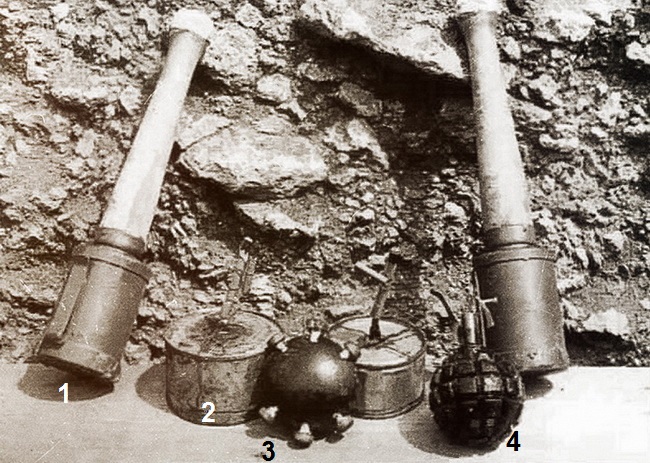
A photo from the trenches of the Great War. 1) Stielhandgranate
with external burning fuse, note lack of safety cap to the end of the
handle. 2)
Trench-made handgrenade, made from recycled food cans. The fuse sits in
the centre of the lid, and must be lit with a flame. 3) Discos
handgrenade, Modell 1913. 4)
Kugelhandgranate
Brennzünder
The Treaty of Versailles of 28 June 1919 imposed huge restrictions on the loosing armies, with some weapon systems forbidden altogether,
like submarines and airplanes. The german army was
restricted both in size, as well as in number of men
and weapons. Due to this the remaining arsenals of
handgrenades had
to be limited, and a total of 16.550.000 hand- and riflegrenades
had to be destroyed. For continued service in the new Reichswehr only a
limited number of Stielhandgranaten 15 mit Brennzünder 15 was allowed
to be kept for further use and training. But these grenades had all been
manufactured during the Great War for instant use, and were not suited
for long storage. Combined with the wish to improve the
Stielhandgranate 15, a new and improved model was ready in 1924-1925,
the Stielhandgranate 24 with Brennzünder 24. As the production of the
Stielhandgranate 24 started up, the old stocks of Stielhandgranate 15
were gradually used up. An order from the Reichswehrministeriums dated
27. January 1927 stated that all existing stocks of
Stielhandgranate 15 should be collected and destroyed (blown
up) on the units' training grounds by the end of March 1927.
Construction
of the Stielhandgranate 24

The Stielhandgranate 24 was made up of 4 main parts.
| 1. The head with the explosive filling |
| 2. The handle with the safety cap and pull cord |
| 3. The Brennzünder 24 (B.Z.24),
friction igniter, pull type |
| 4. The Sprengkapsel No 8, detonator |
The following
text
describes a
Stielhandgranate 24
that was made
in 1940. Certain simplifications to the production procedures were
introduced as the war progressed, and will be discussed later in the
text.
1. The
head
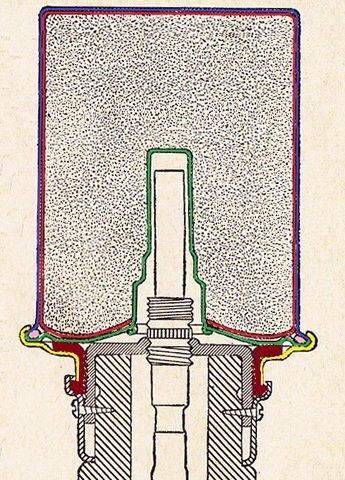 |
|
The head was made of thin sheet steel.
It contained an explosive
charge of 165 g of Füllpulver 02 (Filling powder
02/TNT) or Donarit.
The charge was contained within a waxed paper container (red in the picture to the left)
that fitted
inside the head (blue).
The explosive was covered with a lid (green)
that was slightly concave, and
contained the channel for the detonator tube, the tube being welded or
crimped to
the
lid. The lower cover plate (yellow) contained
the threads (brown) that connected the head with the handle,
and had a beaded design impressed for strength. A oiled paper
ring (pink) was
placed as a seal between the head and the lid, and the cover was crimped
on, visible as the lower edge of the head. Early grenades was
further "weatherproofed" with a secondary coat of paint along the crimp
and the lower part of the can. The can was painted prior to assembly,
so it would have lost some paint during the final assembly crimping
described below. The repainting of the lower edge was discontinued by
1943. |
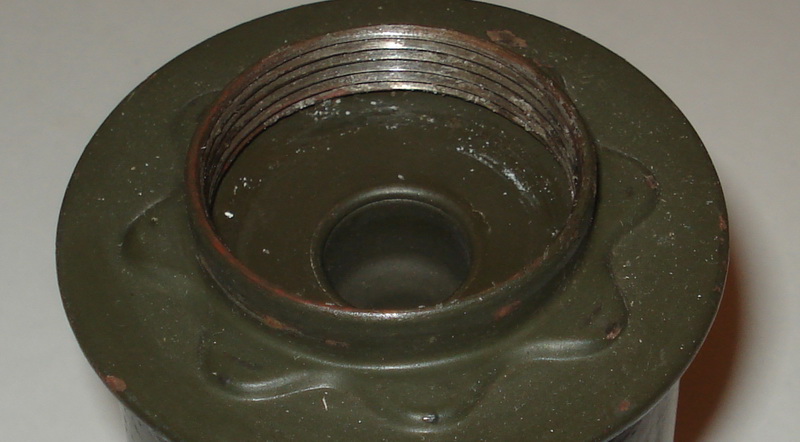 The
lid with the detonator channel is visible under the lower cover plate.
Note that the lid was painted prior to mounting. Also
visible is the beaded pattern pressed into the lower cover
plate
for structural
strength.
The
lid with the detonator channel is visible under the lower cover plate.
Note that the lid was painted prior to mounting. Also
visible is the beaded pattern pressed into the lower cover
plate
for structural
strength.
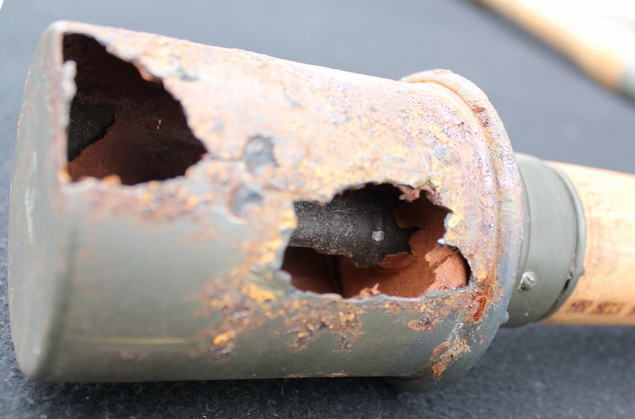
A
very interesting picture. This grenade is in mint condition,
apart
from the heavy corrosive damage to the head. It clearly shows the waxed
paperbag that contained the explosive filling. It is also clear from
this
picture that the detonator channel was pressed into the waxed
paperbag that helSome weapon systems were forbidden altogether,
like submarines and airplanes.d the explosive filling when the lid was crimped in
place
with the lower cover.

On
early heads a painted band appears on the lower part. It will always
differ in color from the spray painted head and it is always applied
unevenly with a brush. This was a finishing touch applied at the
factory to cover areas that had lost its paint under the crimping
process and to improve the weather-proofing qualities.
The explosive filling
The standard explosive in the Stielhandgranate 24 from the start of
production was the Füllpulver 2 (TNT). The total weight of the
explosives was 165 grams. On 16 February 1940 the Chef der
Heeresrüstung announced that the head of the M24 Stielhandgranate was
to be filled with Ammonalsprengstoffen, Manochit I and II
and Donarit I and II, for the rest of the war.
Donarit was made up of 55-84 % Ammoniumnitrat
with up to 22 % Nitroglykol and 11-16 % TNT and could either
have a "flaked" appearence, as below, or could be of a
fine-ground
brown powder substance
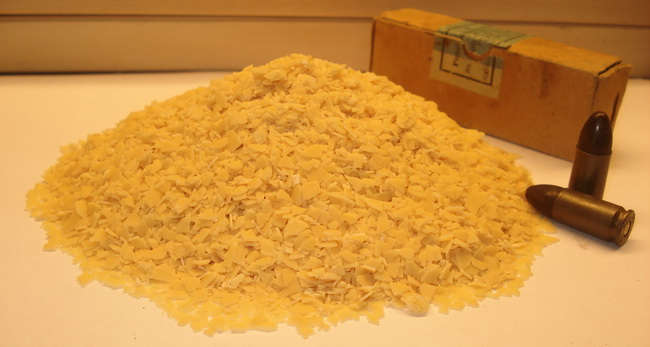
The full contents
of a M24 can of Donarit. (9mm rounds for comparison).
It came in prefilled paperbags from the sub-contractors, so the actual
makers of the Stielhandgranate 24 only placed them inside their own
parts and crimped it all together. The actual waxed paperbag was filled
with the explosive and the top was folded flat. The top was then sealed with
a paper disc that was glued on.
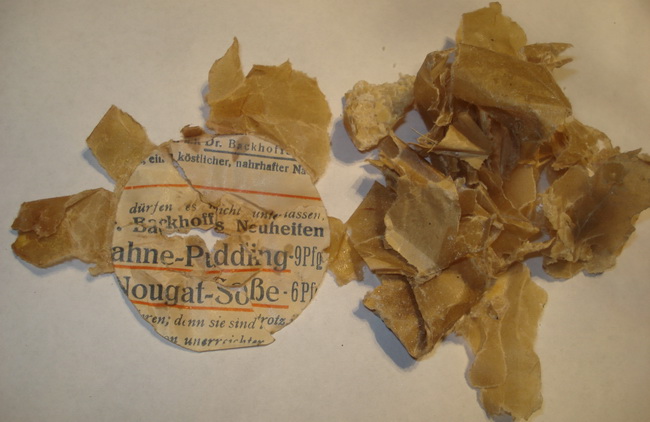
The above paper was removed from a 1941 RR
marked grenade. By
1941 they had started using recycled
paper for the disc. The one above carries a commercial print, and the
words "Pudding" and "Nougat", as well as the price of 9 Pfenning are
readable. The hole where the detonator channel was pressed in when the
lid was installed can be easily recognized in the center of the disc.
2.
The
handle with the
safety cap and pull cord
The wooden handle was hollow, with metal fittings in both ends. At the
top a threaded cap (colored yellow in the picture below) was pressed on
with a sealing compound. The
threaded cap had a links-threaded hole in the center to hold the BZ24.
A
rain-sleeve (red) with a oil-soaked cardboard ring (blue) was attached
with four small wooden screws and held the threaded cap in place while
at the same time providing weatherproofing. The raincap was painted
after installation, with some green paint spilling over on the wooden
handle. This was done to further weatherproof the joint.

Picture
at left above shows the raincap installed with screws and painted in
position. In the right picture above both the threaded cap and the
rain-sleeve has come off,
clearly showing the sealing compound.
The handle is screwed into the threads on the lower cover plate once
the fuze and detonator has been installed.
The
hollow handle contains the fuze and a pull rope that runs down to the
end of the handle.
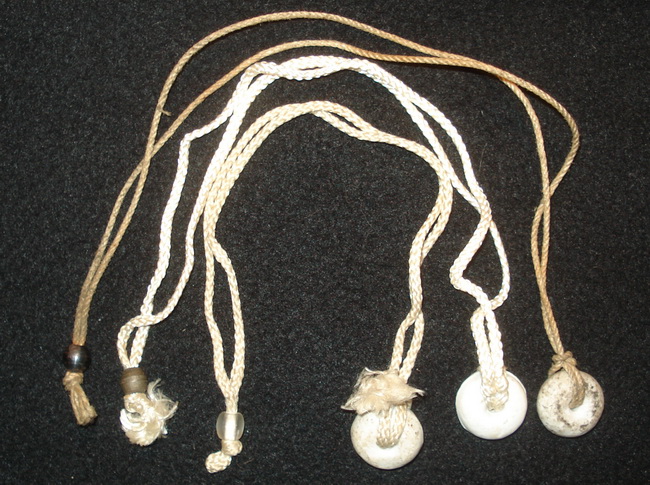
The rope consisted of three parts; the
actual braided rope, a porcelain doughnut to give a firm grip
when
pulling, and a small bead on the opposite end that was used to attach
the rope to the fuze. The porcelain ball stayed the same
throughout the production time, the rope changed from braided to twisted and
the bead changed from lead to glass to iron.
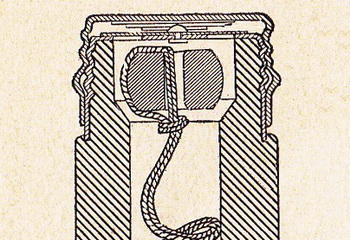
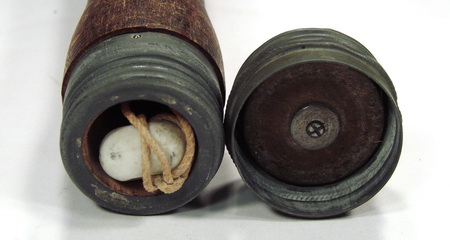
The
threaded ring for the safety cap is pressed on the end of the wooden
handle with a sealing compound and secured with tiny nails.
A safety cap with a spring
tensioned cardboard disc closes the handle end to add pressure
on
the porcelain ball to stop it from rattling, and makes the end
weatherproof.
The handle is made of hardwood and soaked in linseed oil to
make it weatherproof.
3. The
Brennzünder 24
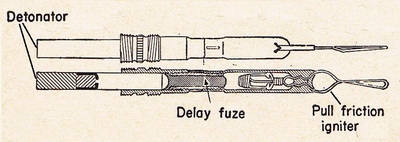

Brennzünder
24 can be loosely translated as "Burning fuse, Model 1924". It is a
waterproof metal detonator with a fixed burning time of 4,5 seconds.
The
igniter consists of a leadtube or sheath connected to a threaded alloy
metal
fitting by a steel tube (covered in red or black laquer in the picture above).
The steel tube is threaded on both ends and
contains the powder delay pellet. The lead sheath contains a copper
capsule which holds the friction composition. A friction wire is coiled
to provide resistance to pulling and is joined to the pull loop. The
pull loop extends through the lead tube, which is flattened or pressed
together at the upper end, thus preventing the loop and friction wire
from being freely and inadvertently withdrawn. When the loop is pulled,
it frees itself
from
the soft lead tube, drawing the friction wire through the friction
composition contained in the capsule. The resulting flame ignites the
delay pellet. When the delay pellet burns through, it ignites a fuze or
a detonator attached to the fitting. The pellet used with the stick
grenade has a delay of 4,5 seconds, accuracy is +/- 0,2 seconds, the
delay time is printed on the body of the fuse with the text "4.5 S".
The
end of the Brennzünder is threaded on the outside to accept the
Übungsladung 30. This will be described in the section deling with the
Übungsstielhandgranaten 24. The colored laquer applied to the end and
center of the BZ24 was meant as a protection against moisture. The
color has no significance. The picture above displays a early fuse with
red laquer, and a late fuse with black laquer.
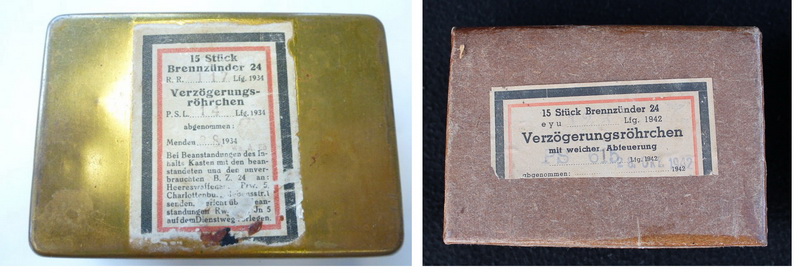
The Brennzünder 24 came in boxes of 15, sealed with wax or tape. Early
boxes were cupper-plated steel, second generation boxes were steel
painted green and the third generation boxes were made of waxed
cardboard. "Verzögerungsröhrchen"
translates to "Delay tubes", and "mit
weicher Abfeuerung" means "with soft firing". The last
text is a
warning found on boxes manufactured from 1942 and onwards. When the
cord was
pulled this igniter would give no hint if it did in fact fire or not
(but it would fire). To hang on to the grenade to see if it worked was
not a good idea....

As the war progressed the supply of lead quickly became a problem, and
it was listed as a "scarce" metal. The Brennzünder 39
(above) was manufactured with the use of alternative metals, exchanging
the
lead with aluminium and using rubber seals. The time delay was the same
as the Brennzünder 24, but it was not printed on the body any
more. An interesting fact is that the US Technical manual over German
explosive ordnance, dated March 1953 claims that the burning time for
the Brennzünder 39 is 7 seconds instead of the correct 4.5 seconds.
The
Brennzünder 39 was introduced as a new fuse for the Nebelhandgranate
(the smoke handgrenade strongly resembling the Stielhandgranate 24),
and as a replacement for the Brennzünder 24, previously used with the
Stielhandgranate 24 and the Übungs-Stielhandgranate 24. It was
introduced on 20. August 1940 by the Oberkommando des Heeres, but
didn't last too long. Due to fatal accidents a new order was issued in
November 1941 that limited the use of the Brennzünder 39. It was only
allowed for use in Nebelhandgranaten after this date.
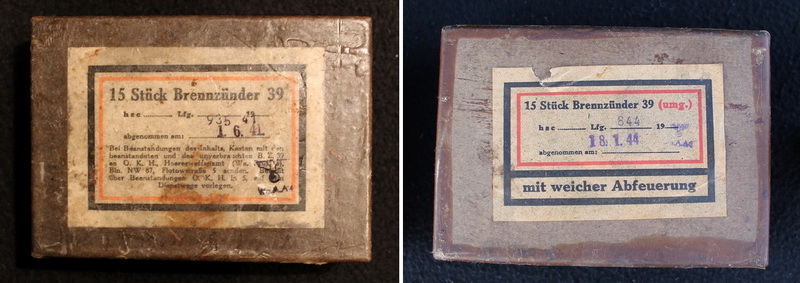
The Brennzünder 39 came in boxes of 15,
sealed in waxed
cardboard boxes. The late war boxes carried the same warning as the
Brennzünder 24 boxes; "mit
weicher Abfeuerung".
A
new version was introduced in March 1943 called the "Brennzünder 39
(umg.)", "(umg.)" being the abreviaton for
"umgebaut" (right picture above). Translated
it would read "Burning fuse model 39 (reconstructed). This totally new
and longer fuse caused problems. The fuse could no longer be used in
the Nebelhandgranate as it would not fit, but was now ready for duty
with the Stielhandgranate 24, once again replacing the Brennzünder 24.

A paper tag from inside of a transportation box. It states that the box containes 15 Brennzünder 39 (umg.) and 15 Sprengkapseln Nr. 8.
4. The
Sprengkapsel No
8
The commercial "Sprengkapsel no. 8" was used as detonator.
It is a small, open-ended tube made of aluminum with a 2 grams load. Very early versions were made of copper.
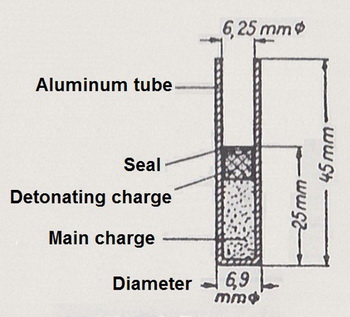
The
explosive in any handgrenade contains an amount of potential energy,
but to release the energy it must be detonated. Explosives used in
handgrenades are formulated as insensitive as possible, to make them
stable and safe to handle. They will not explode if accidentally
dropped, mishandled or exposed to fire. In order to detonate a
handgrenade, a detonator (or blasting cap) is needed. The detonator
contains an explosive that is easy to ignite and which will provide the
energy needed to start a detonation in the more stable explosive used
in the handgrenade. This is the reason why the Stielhandgranate 24 was
shipped without the detonators or fuses installed.
The
detonator itself consisted of a aluminum tube of 6 mm that contained a
2 grams load of Tetryl as the main charge (explosive) and lead azide as
the initiator. The heat emitted from the fuse when the time-delay
pellet had burned through would be sufficient to trigger the lead azide
to explode, setting of the Tetryl. The Tetryl as a high explosive would
in turn detonate the Donarit explosive charge in the handgrenade head.
The
detonator was very susceptible to moist, and a drop of rain inside the
detonator would most probably lead to a misfire. To prevent this from
happening the detonators, as well as the fuses, would be kept in sealed
containers until they were supposed to be used.
The
number assigned to the detonator (Sprengkapseln No 8) is a result of
the amount of explosives in the tube. For reference a number 6 would
contain 1 gram, a number 8 would contain 2 grams and a number 10 would
contain 3 grams. The primary detonator for all military demolition work
is the "Detonator no 8".
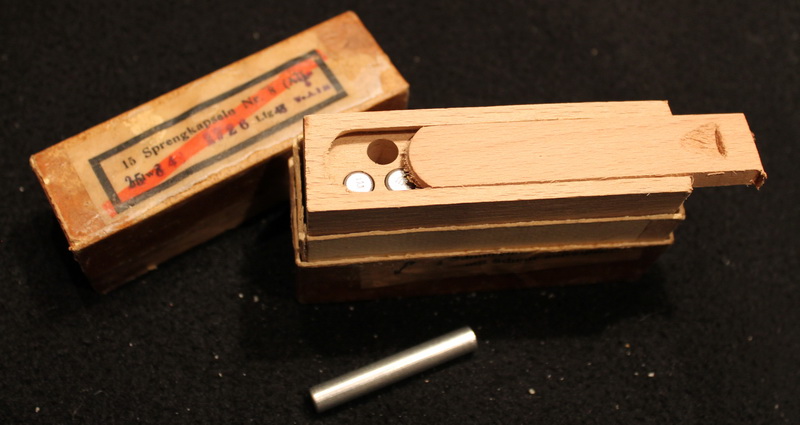
The Sprengkapseln No 8 came in a wooden box that contained 15, each Sprengkapsel
stored in a
separate room. The wooden box was again covered by a cardboard box
again covered in wax, to ensure that the detonators didn't get moist.

The
same product was also delivered in boxes of 100, but these
Sprengkapseln were meant for explosive charges, demolition and
construction work only.
Product-evolution of the
Stielhandgranate 24
The first version of the Stielhandgranate 24 had a
head that attached
to the handle with links-threads (not to be confused with the Brennzünder 24, which was
links-threaded from start to finish). A change to standard threads came
towards the end of the 1920's and the remaining stock of
Stielhandgranaten 24 with links-threads were handed over to the German
Police. The first version of
the Stielhandgranate 24 had
a Trageösen
(carrying
eyelet) that was welded to the side of the can, close to the top. This
eyelet would be used together with a special spring,
a "Tragefeder", that attached to the bayonet frog on the
belt.

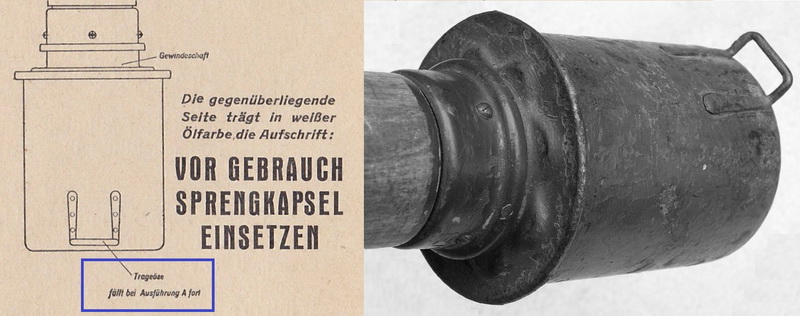
In
a manual dated 1940 named "Waffentechnische Unterrichtsbuch" by
Schmitt, the Trageösen was still part of the drawings of the grenade,
but the text states that "Trageösen fällt bei Ausführung A fort"
(Carrying eyelets will be discontinued with the A model). This is the
only reference to separate "models" ever encountered in the
original documentation from the era.
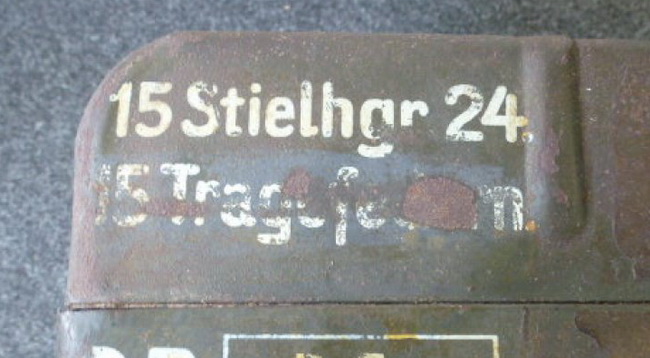
It
is no longer known what the "Tragefeder" looked like. They were
supplied in the same numbers as the Stielhandgranate 24, and came in
the same boxes.
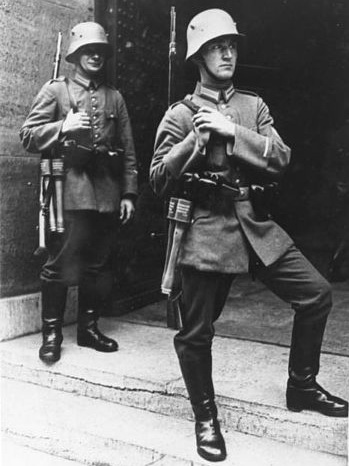
The
above picture from 1 July 1932 shows two Reichswehr soldiers guarding
the Reichswehrministerium in Berlin. They are both armed with Mauser
rifles and two Stielhandgranate 24. The Trageöse and Tragefeder is
clearly in use, even though details can't be seen.
In
the Heeres-Verordnungsblatt Nr. 10
from 5
April 1933 it was announced that the Trageösen
and Tragefeder would
be
discontinued altogether.
The Ausführung A had a
safety cap that was
similar to the ones used on the Stielhandgranate 15, but the WW1
model had a star shaped disc riveted to the bottom.

The initial one made for the Stielhandgranate 24 also had a star shape,
but this was done by simply shaping the upper edge of the cap. This
model seems to have been discontinued around 1936-37. These caps are
often
wrongly identified as a special "winter-model" to ease the unscrewing
with mittens on. The early WaA found on these (picture above left)
should have been a dead
give-away!
The next simplification came in April 1940, when it was decided to
discontinue the painting of the white text "VOR
GEBRAUCH SPRENGSKAPSEL
EINSETZEN" on the heads.
The
next to disappear was the painted band applied to the lower part of the
head for weatherproofing. This was discontinued sometime around 1941-42.

Then
another production simplification was introduced. From 1942 the
raincoat was no longer attached with 4 small screws. Instead of the
screws 4 triangular cuts were pressed into the raincoat when it had
been mounted on the handle, thus attaching both the raincap and the
threaded cap to the handle.
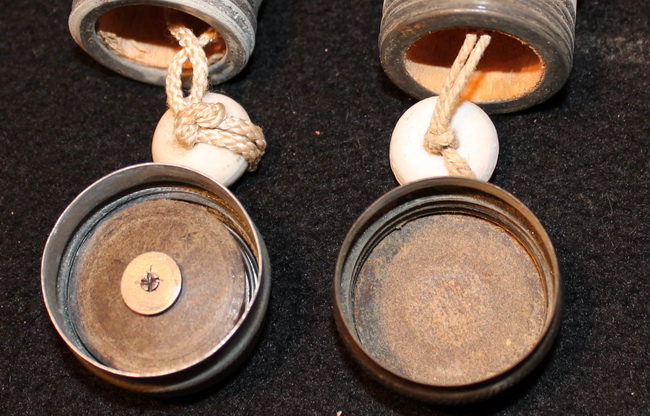
In
1943 the safety cap was simplified. The spring and cardboard disc was
replaced with a simple cardboard disc. This one no longer added any
pressure to the porcelain ball, it simply sealed off the end and
weather-proofed it.
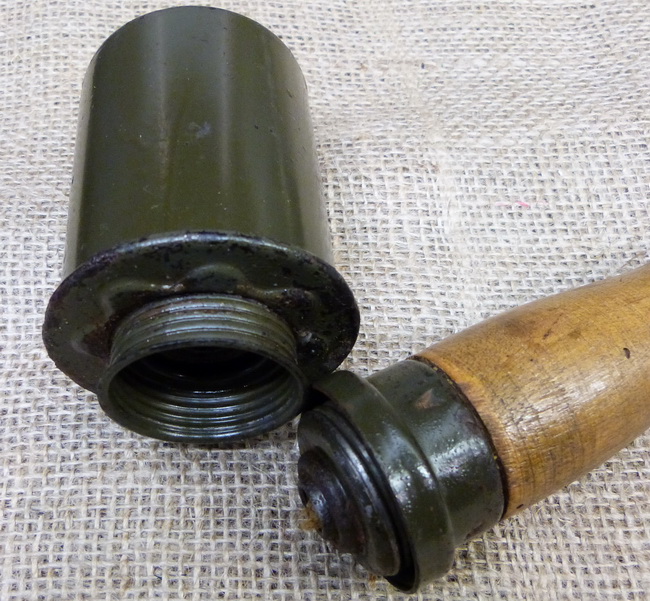 The
last production improvement was introduced in 1943, but has only been
observed on Stielhandgranaten 24 made by Metallwarenfabrik Hermann
Nier, Beierfeld, code fcc.
The design of the screw attachment between
the handle and the head was simplified with pressed threads instead of
the more time-consuming machined threads. The lower edge of the
threaded part of the can was pressed out into a flange that would sit
against the oilsoaked cardboard ring between the threaded cap and the
raincoat. This late variation was only made by Metallwarenfabrik
Hermann
Nier and must be considered a makers product improvement, and not a new
"model".
The
last production improvement was introduced in 1943, but has only been
observed on Stielhandgranaten 24 made by Metallwarenfabrik Hermann
Nier, Beierfeld, code fcc.
The design of the screw attachment between
the handle and the head was simplified with pressed threads instead of
the more time-consuming machined threads. The lower edge of the
threaded part of the can was pressed out into a flange that would sit
against the oilsoaked cardboard ring between the threaded cap and the
raincoat. This late variation was only made by Metallwarenfabrik
Hermann
Nier and must be considered a makers product improvement, and not a new
"model".
The finish on the
individual parts detoriated through the whole production periode, and
was different from one manufacturer to another. The raincap is one
example. During the war-production it was no longer painted after
installation for added weatherproofing, but painted during production
prior to assembly. Some manufacturers stopped painting it allready in
1940 using phospathing instead (see picture below right), while other
manufacturers kept on
painting them until 1944. For further details see the section about
each individual manufacturer.
Markings
The following description is valid for a mid 1940 manufactured
Stielhandgranate 24. The markings on the Sprengkapsel and Brennzünder
was described in the description above. The "identity" markings on the
Stielhandgranate 24 consisted of the normal combination, found on most
German WW2 ordnance and weapons related equipment.

A
WaA (approved by an inspector) mark can be found on the head (white ink
or metal-stamp), on the upper part of the handle (wooden stamp
with black ink) and on the safety cap at the end of the handle on early
versions (metal
stamp). The year of manufacture and makers code/mark can be found on
the handle (hot-iron) and top of the can (metal stamp). Up until 1942
the full four digits were used for the year of manufacture. From 1942
only the last two digits were used (42-43-44-45), and some factories
actually stamped the last digit from the end of 1944 (4-5).
The code
"RR564"
on this example is "Wilhelm von Hagen Metallwarenfabrik, Iserlohn
Westfalen"
For further details see the section about
each individual manufacturer.
The inked markings on the side
of the can relates to the explosive filling of the paper bag that has
been placed inside the head. Since the explosive came from a
sub-contractor, the assembly plant had to mark the heads with
the ink-stamps to denote the contents. Different
explosive manufacturers supplied the waxed paper bags filled with the
Füllpulver 02 or Donarit to the different Stielhandgranate 24
manufacturers. The above marking is "K 4 8/40".
The
"K" stands for Kalt (cold), denoting that the explosive was guaranteed
to function as normal even in arctic climates. "4" presumably denotes
the type of explosive filling, and 8/40 is August 1940.
Up until 1940 the ink stamp will tell who made the explosives and when.
From 1940 and onwards the ink stamp will specify the type of explosives
and when it was made.

A
late war version. "K syn Do 3/1944" should translate to
"For use in Cold weather, filled with synthetic Donarit, made in March
1944".

6
different varieties. Upper row shows Donarit filled cans from 1940 to
1944. Lower row shows that the explosive fillings were manufactured by
WASAG. "Rdf."
is a code from the code system for explosive manufacturers, that was
introduced on 07.09.1936. "Westfälische-Anhaltische
Sprengstoff AG, Werk Reinsdorf" was often shortened
as "WASAG", but here it is the location Reinsdorf that has been coded
to "Rdf". Incidentally the code "Rdf." was only lightly changed when
the new three-letter code system was introduced in 1940. The new code
was "rdf". The lower
row doesn't state what kind of explosive the cans have been filled
with, only who made it and when.
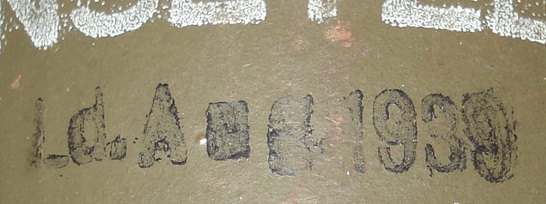
The above marking reads "Ld.
Aug 1939" and denotes that the explosives were made in
August 1939 in Lechfeld
& Depyfag G.m.b.H, Werk Neumarkt/Oberpfalz.

The above marking reads "Sk. 4 1939" and
denotes that the explosives were made in April 1939 in Lignose
Sprengstoffwerk GmbH, Werk Schönebeck, Elbe.
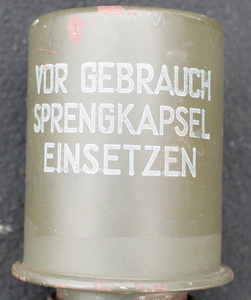 |
The
classic. All Stielhandgranaten 24 should absolutely look like
this, with the full white text to the side of the can. But no such luck
for most, unfortunately.
"VOR
GEBRAUCH SPRENGSKAPSEL
EINSETZEN"
is a
warning. Directly translated it means "Before use insert detonator".
The grenades could not be shipped and stored "live", so the units had
to insert the fuse and detonator themselves. This text was added to the
cans from the start of production in 1924 until April
1940. |
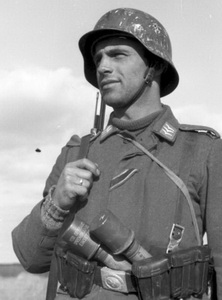 |
| After
this
date the text would not be painted on the cans. The
grenades
manufactured pre April 1940 would of course be used until the end of
the
war, and it is not unusual to find pictures from 1944 with
Stielhandgranaten 24 with the full text painted on the head. But a
Stielhandgranat 24 manufactured (and dated) after April 1940 should not
carry the text on the can. |
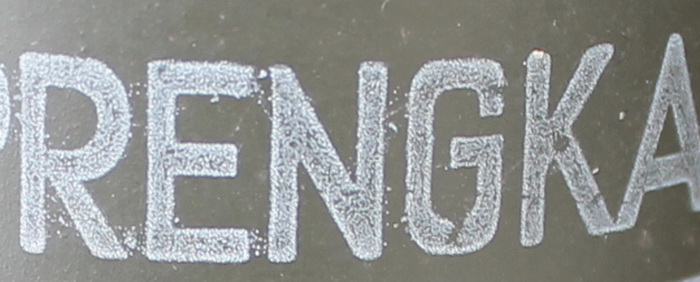
The text was always in white paint, and applied with a rolled stamp,
leaving a
pattern of micro-dots. Original Stielhandgranaten has been observed
with yellowish paint, but these have become yellow due to a postwar
coating of laquer, or simply from aging. The factory color was always
white.
The following
markings are not that easy to explain, but will be included anyway.

This 42
evy has a red ring painted around the handle, but the
purpose
is not known.

Cans marked with a yellow ring in the same spot as the waterproofing
was normally applied. Several of these grenades are known, but no good
theory why the ring is present has been fielded yet.
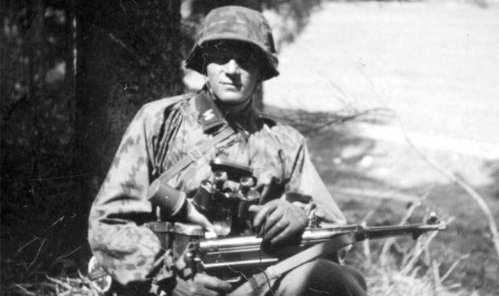
A
SS Unterscharführer with a Stielhandgranate 24 in his belt. It is hard
to tell if the lighter colored ring around the crimped area of the can
is a yellow ring or just the secondary paint applied at the
factory.

This brb
43
has a black painted ring around the upper lip of the raincoat.
Undoubtebly periode done, but not explainable.
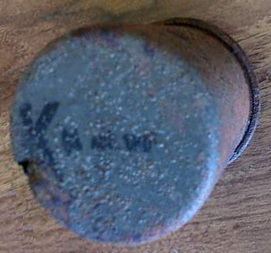
A can with the filling details stamped to the top of the head instead
of the usual position, to the side of the can.
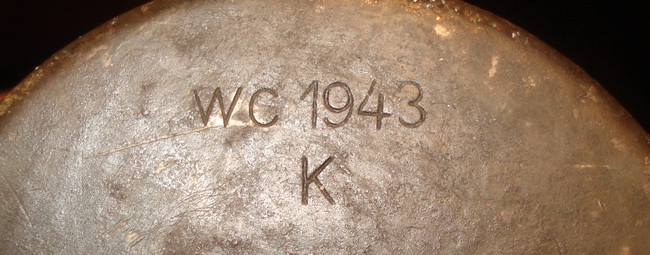
A wc
1943, manufactured by Hasag, Hugo Schneider AG,
Metalwarenfabrik
Leipzig, werk Meuselwitz, Thuringia. The makers marking is followed by
a large "K".
The reason for this added marking is unknown. What springs
to mind is that it is supposed to "mirror" the large "K" stamped
in ink to the side, but that wouldn't make sense, as the filling of
explosives was delivered by another manufacturer.
Richard
Rinker, the main player
According
to the Treaty of Versailles of 28 June 1919 the german army was
restricted both in size, as well as in number of men
and weapons. Article 168 restricted the number of
manufacturers that was allowed as
suppliers of ordnance to the german army, and specified a list of the
approved manufacturers. Each weapon type or
accessory could only be made by one approved company, and some
companies even made several items. The
company of
Richard Rinker G.m.b.H. in Menden/Iserlohn was selected as the
sole
manufacturer of "Artikel 17, 18, 19 und 20. Stielhandgranaten,
Eierhandgranaten, Gewehrgranaten und dazuhörige Zünder".
Westfälische-Anhaltische
Sprengstoff AG, Werk Reinsdorf (WASAG) was also on the list, and
was the sole supplier of explosives.
The
company of Richard
Rinker was founded in 1910 and was specializing in forged parts of
brass for the building industry. One of their first products were
doorknobs. Towards the 1930's most of their output was based on
stampings and sheet-metal products. Their domestic items production was
stopped in the prewar era, as all their capacity was needed for
military purposes. Their company logo was a stylized double "R" with
the first letter inverted, the letters joined at the midle,
and with the letters in a font remnisicient of the Art Deco style of
the 1920's. Note the big, bulging "stomach" and the very short legs.
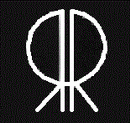 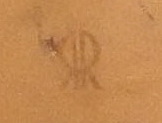
The company logo to the left above. The other picture shows a ink stamp
from the company found on a cardboard plate with a cut-through
Stielhandgranate 24.
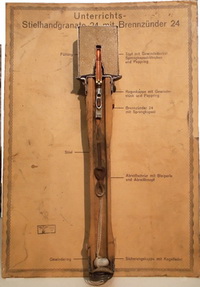
Click on the above picture for a full size picture of the instructional
chart.
Since the Stielhandgranate 24 litterally was a "use and throw away"
item, it is difficult to find a complete series of early versions to
study. The initial marking on their products to represent "Richard
Rinker G.m.b.H. in Menden/Iserlohn" was the company logo shown
below. The code used by the Waffen Amt
inspector at this factory was WaA65,
although reading the numbers in ink can be hard sometimes.

In 1925 a coding system consisting of three numbers were introduced. Richard
Rinker G.m.b.H. in Menden/Iserlohn was assigned the code "336", but did
not use the code until the outbreak of war. In 1940 their products
could be marked RR 1940, 1940 336
and even RR 1940 336.
 From April 1940 a new system was introduced that was
meant to replace all previously used codes, company logos or fulltext
names of manufacturers. The system was meant to prevent allied sabotage
or bombing, by hiding which companies made which items and as a result
were important strategic targets. Richard
Rinker G.m.b.H. in Menden/Iserlohn was
issued the manufacturers code brb.
For unknown reasons this code was not placed on their products until
mid-1941. The "336" code was followed by yet another periode using the
"RR" logo before the brb
code was fully incorporated in 1941. It stayed on their products until
late 1944 at the least. No 1945 dated brb marked product
has been found so far, so it is possible that the code was changed in
late 1944, but the new code is not known.
From April 1940 a new system was introduced that was
meant to replace all previously used codes, company logos or fulltext
names of manufacturers. The system was meant to prevent allied sabotage
or bombing, by hiding which companies made which items and as a result
were important strategic targets. Richard
Rinker G.m.b.H. in Menden/Iserlohn was
issued the manufacturers code brb.
For unknown reasons this code was not placed on their products until
mid-1941. The "336" code was followed by yet another periode using the
"RR" logo before the brb
code was fully incorporated in 1941. It stayed on their products until
late 1944 at the least. No 1945 dated brb marked product
has been found so far, so it is possible that the code was changed in
late 1944, but the new code is not known.
Sometimes during the mid-30's the increased need for grenades could not
be covered by the output from the factory in Menden (brb), and a second
Richard Rinker factory started manufacturing the
Stielhandgranate
24. This was the Richard Rinker GmbH, Neubrandenburg in Mecklenburg, which
from April 1940 was
issued the manufacturers code dbk.
The code used by the Waffen Amt inspector at this
factory was WaA560.

Although the second Richard Rinker factory used the same factory logo
it is possible to tell them apart. The brb factory in
Menden kept on using the Art Deco style "RR", while the dbk factory in
Mecklenburg simply used a standard "RR" (small stomach and long legs)
with the first letter inverted. Also easily recognizeable by the
WaA560, although the ink often is smeared out and unreadable it is most
of the time possible to tell if it has two or three digits.

From 1925 to 1935 all years of manufacture were to
be coded as well, using a capital letter. This code can be observed on
Richard
Rinker made products predating 1935. The above handles for
Übungshandgranaten (the ones most likely to survive!) were
made by Richard Rinker and dated "M" for 1927
and " G" for 1935.
Increased needs and new makers, the "RR" mystery
As mentioned above, the strict treaty of Versailles
only allowed
Germany to manufacture its military hardware in certain factories. But
for the rising Reichsheer, and later Wehrmacht, the need could not be
met by these factories alone. Contracts were drawn up with other
manufacturers, but they had to mark their products in a way that made
it look like Germany still stood by its obligations in the
treaty. In 1925 a code system consisting of two or three
numbers was introduced.
Simson Werke in Suhl was appointed as the sole manufacturer of small
arms, and was issued the code "S". All other manufacturers of small
arms were disguised by using the same "S" code
followed by the code number. As an
example, Mauser-Werke AG,
Oberndorf an Neckar used the code S/42. The manufacturers were
not
in any way under the administration of Simson, the coding was simply a
way to disguise the breaches of the Versaille treaty.
The same system was also used within the production of small arms
cartridges and artillery cases. The sole manufacturer under the
Versaille treaty was the company of Polte Armaturen- u.
Maschinenfabrik AG, Magdeburg, Saxony, later renamed Polte-Werke,
Magdeburg. They used the code "P", and all other
manufacturers of ammunition
contracted
by the Heeres Waffen Amt were disguised by
using the same "P" and their respective code numbers. As an
example, P131 was the code for DWM (Deutsche Waffen- u.
Munitionsfabriken AG, Berlin-Borsigwalde).
The same system was of course also used to disguise the manufacturers
of grenades, fuzes and mines. Richard Rinker, Menden was listed as the
sole manufacturer. Any other company manufacturing the same type of
ordnance
was disguised with the code "RR" and a
identity number of two or three digits. The tricky part was
that the company of Richard Rinker didn't use normal letters on their
products, they used the Art Deco logo. This lead to an array
of different versions of the "RR" code, followed by the identity number.

A sampling of manufacturers markings on Stielhandgranate 24 cans. The
first is the company logo of
Richard Rinker. The second picture is the marking of "564", which was
Wilhelm von Hagen Metallwarenfabrik, Iserlohn Westfalen. The "RR" is a
not quite perfect copy of the Richard
Rinker
logo. The third picture is the marking of "217", which until now is
unknown. The "RR" marking is a reversed "R" followed by a normal "R",
but
they are linked at the midle, like the original logo. The number is
also followed by a hyphen. The fourth picture is the
marking of "90", which was Bergmann elektrizitätswerke AG, Berlin
Wilhelmsruhe. The "RR" marking is a
reversed "R" followed by a normal "R", but they are not linked at the
midle, like the original logo.
The last picture
is the marking of "517.", which was Metallwarenfabrik Siegwerk Gebrüder
Schuppener, Siegen. The "RR" marking is simply two normal capital
letters, but this
company
persistently used a dot after the number. So to sum it up; all
manufacturers followed the standard coding system of "RR xxx", although
there were several ways to write "RR". To complicate matters, some of
the makers even changed the way of writing over the years. This system
was gradually replaced with the three-letter codes from April
1940, but as an example, Richard Rinker kept
on using their logo until well into 1941. The different manufacturers
will be discussed more thoroughly at the end of this article.
The
change to the Stielhandgranate 43
By 1942 the combined yearly output of all manufacturers of the
Stielhandgranate 24 had reached a total of 5.912.000 pieces, but
production capacities had reached it's limit. Simplifications of the
existing design had eased some of the burdens, but they were simply not
enough. A whole new design was needed to save both labour hours and raw
materials. The simplified model was designated Stielhandgranate 43 and
it was announced in the "Heerestechnische Verordnungsblatt" dated 1 May
1944. The production started in 1944 and continued into 1945. The
change in production from the Stielhandgrante 24 to the Stielhandgrante
43 must have taken place quite rapidly for all of the manufacturers,
with Metallwarenfabrik Hermann Nier, Beierfeld,
code fcc
being the last one. 1944 dated Stielhandgranate 24's are scarce, with fcc 44
marked ones being the most common one. Metallwarenfabrik
Hermann Nier is also the only observed manufacturer that painted his
Stielhandgranate 24 in Dunkelgelb.

The
main modification was the simplified handle. The new handle saved the
industry from drilling out 6 million handles yearly and the
manufacturing and installation of 6 million safety caps, porcelain
balls, strings, rain caps and thread caps each year. The new handle
simply had a metal cap with pressed threads crimped to the end of the
handle. The head could be carried and thrown
like the Eihandgranate 39 by removing the handle. The
detonator channel was no longer attached to a separate lid, but was now
mounted directly to the top of the head and had threads to accept the
fuse.
Apart from the much simplified manufacturing
process the new model also had the advantage of much better and easier
waterproofing. The head was hermetically sealed and the fuse was
screwed into the fuse channel sealing off the access to the
Sprengkapseln once installed.
The Stielhandgranate 43 was also claimed to be easier to handle, with
the fuse in the top of the head.

The Brennzünder 24 was replaced with the
Brennzünder für
Eihandgranaten 39 with modified wings. The old model had downfolded
wings that would follow the contour of the egg, but would not have
fitted the head of the new Stielhandgranate 43. The sole mission of the
wings was to assist in the mounting and removing of the fuse.
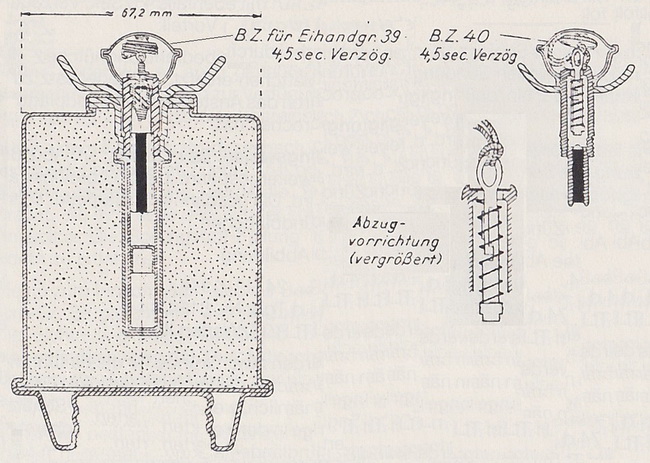
The Brennzünder für Eihandgranaten 39
worked on the same principle as the Brennzünder 24. Drawing
the friction wire through the friction
composition contained in the capsule would result in a flame that
ignited the
delay pellet. When the delay pellet burned through, it ignited the
detonator.
In
December 1944 a new fuse was introduced to replace the Brennzünder für
Eihandgranaten 39, the Brennzünder 40. Outwards the fuses
looked
identical, but the ignition system was completely different. The
Brennzünder 40 consisted of a spring loaded striker and a small
percussion cap. A strong puburnt or pressed into
the handle, and ll on the rope causes the
striker release
plate to be drawn from the the igniter body, carrying with it the
striker and compressing the striker spring. When the release plate is
withdrawn fully from the igniter body, it disengages from the striker
and the striker is relased. The compressed striker spring then forces
the striker to impinge upon the percussion cap. The percussion cap will
then ignite the delay pellet, burning for 4.5 seconds.
The problem
with both the Brennzünder 24, the Brennzünder 39, the Brennzünder 39
(umg.) and the Brennzünder für Eihandgranaten 39 had been the "soft
firing", written as the warning "mit
weicher Abfeuerung" on the boxes. The soldier igniting the handgrenade
would have no warning to tell him if he had in fact succeeded to ignite
the delay pellet, leading to fatal accidents. The new Brennzünder 40
would give off a sharp sound when the striker ignited the percussion
cap, actually saving lives!
Both the Brennzünder für Eihandgranaten 39
and the Brennzünder 40 had a blue head (Blaukopf), denoting a
4,5 second delay.
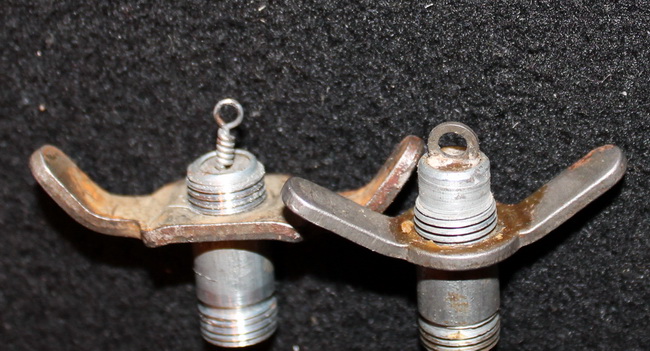
The Brennzünder
für Eihandgranaten 39 and the Brennzünder 40 looks identical
on
the outside. To tell them apart the ball has to be unscrewed, and the
anchorage for the pull string inspected. The Brennzünder
für Eihandgranaten 39 will have a coiled wire and the
Brennzünder
40 will have a striker release plate instead.
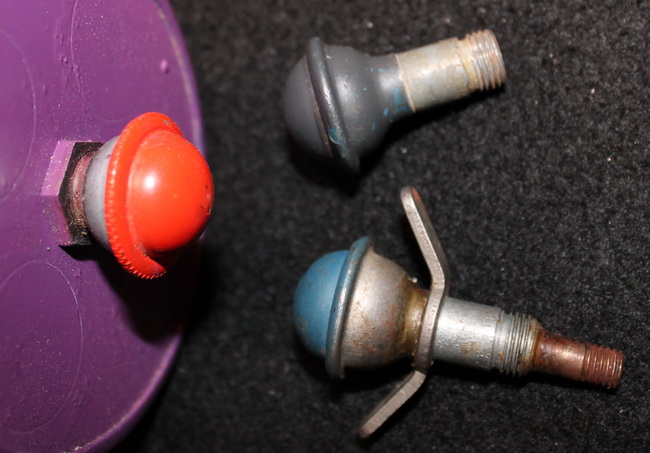
Different versions of the Brennzünder. Red head (Rotkopf) has a 1
second delay, mostly used in boxes of colored smoke and message boxes
dropped from aircraft. Gray head (Graukopf) was instant, used for
demolition work, booby traps and ignition of
black powder fuses. Blue head (Blaukopf) had a 4.5 second delay, used
in different types of handgrenades.
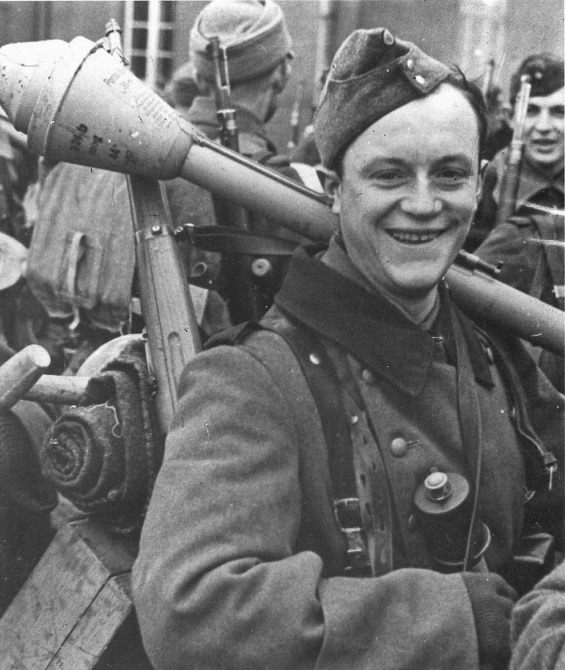
The Stielhandgranate
43 was mainly delivered in Dunkelgelb (tan) color, but some (early?)
examples came in the same ordnance green color as the Stielhandgranate
24. The markings followed the same pattern as the Stielhandgranate 24,
with black ink denoting the explosive contents.

The
makers code and year of production was metal-stamped
both to the top and the bottom of the head, and burnt
or pressed into the handle.
Registered manufacturers of the Stielhandgranate 43 so far includes evy,
bdp.,
fcc,
brb,
wc,
flf,
gck
and prd.
prd
is a "second generation code", and not a new maker. The code was
assigned as a new code to a company allready registered under a
different code towards the end of 1944. I suspect prd
might be the new code for brb,
but no evidence has surfaced so far. For
further details see the section about each individual manufacturer.
The
Übungs-Stielhandgranate 24

The Übungs-Stielhandgranate 24 followed quickly after the introduction
of the Stielhandgranate 24. It closely resembled the original in weight
and form, but the head was specially constructed. The upper part had 8
holes for gas evacuation, and the top was concave to better withstand
the gass pressure created by the training charge. The lower part of the
head that held the threads was pressed on the upper and secured with 6
rivets. The thicker metal used for the head compensated the weight for
the missing explosives. Both the head and the raincoat on the handle
was painted red, for ease of observation once thrown and to avoid
confusing it with a real Stielhandgranate 24. The handle had
a reinforced thread cap to better withstand the gas pressure,
and was marked with "Ueb" or "Üb" in the same area as the standard
markings applied to the handle. The first generation had a Trageöse
riveted to the head, resembling the original but much sturdier. The
production of the Übungs-Stielhandgranate 24
followed the standard production, with the same simplifications to the
manufacturing proces.
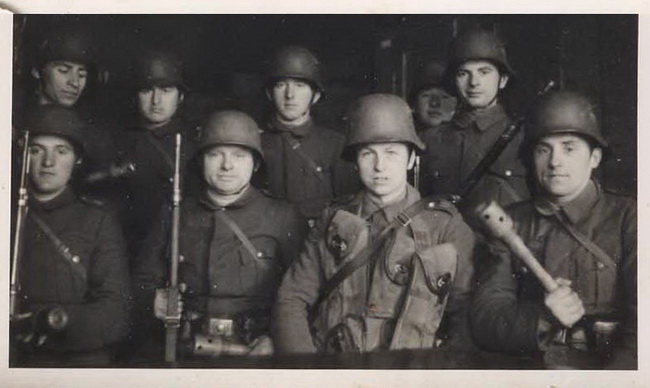
Reichswehr soldiers posing, ready for training. There are four
Übungs-Stielhandgranaten visible in the picture.
The handling and priming of the Übungs-Stielhandgranate 24 was done in
the same manner as the Stielhandgranate, except for the fact that the
detonator was exchanged for a Übungsladung 24 or 30.
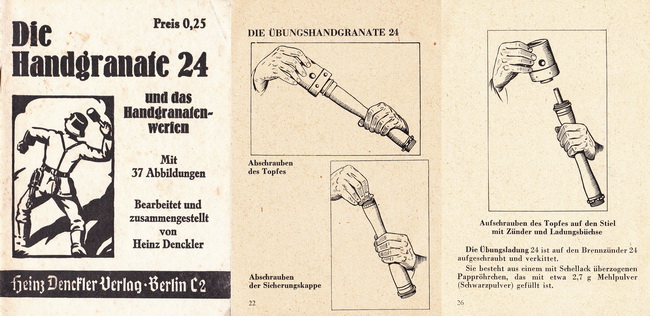
See pages 21 to 27 in the publication "Die Handgranate 24 und das
Handgranatenwerfen".
The Übungsladung 24 consisted of a laquered cardboard tube filled with
2.7 grams of blackpowder. According to the manual above it was
delivered allready attached and sealed to the Brennzünder 24. No
picture of the Übungsladung 24 is known to exist. This training charge
must have been unsatisfactory, both in construction and handling, as
the replacement came swiftly. The new model was called the Übungsladung
30. The standard Brennzünder 24 could now be used, as the
mushroom-shaped Übungsladung 30 simply
screwed on to the end of the Brennzünder, replacing the detonator in
the live handgrenade. The mushroom contained a charge of blackpowder
and was constructed to disintegrate into a few, large pieces that would
be too big to escape through the gas-escape holes in the head.
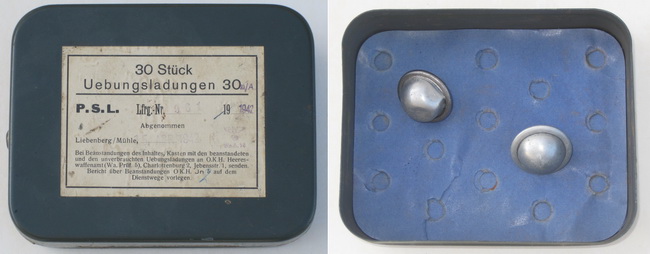
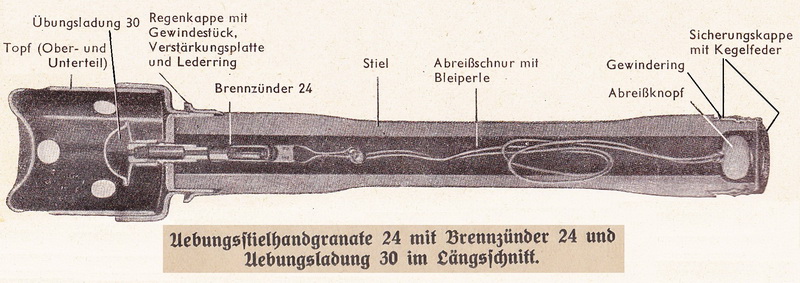
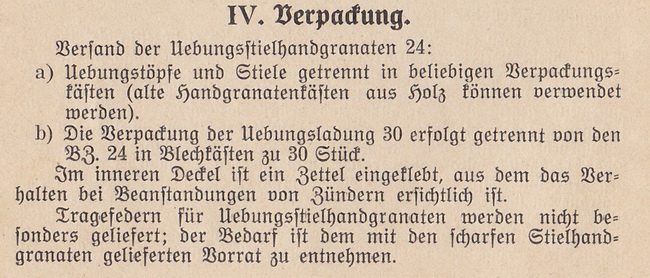
The text above is from the 1940 dated manual
named "Waffentechnische Unterrichtsbuch" by
Schmitt. It states that the Übungs-Stielhandgranate
24 did not come in a special box, but old transportation boxes for the
Stielhandgranate 24 could be used. Also worth noting is the information
that "Tragefedern for Übungs-Stielhandgranaten
will not be delivered, the units must use the ones supplied
for the Stielhandgranaten 24."
During training manouvers in 1928 it was reported that
too
few of the special springs were available for the troops.

The
same publication also describes the Trageöse and the fact that it will
be discontinued, 7 years after it actually was removed from
production....
No signs of a Übungs-Stielhandgranate resembling the Stielhandgranate
43 has ever been observed.
The
fragmentation sleeve
The Stielhandgranate 24 contained 165 grams of
explosives, and
would have a fatal effect on personell within a radius of a few meters
from the blast. The thin metal casing only gave off a small element of
fragmentation. The idea behind the Stielhandgranate 24 was that it was
an
offensive weapon, and should not be a danger to the user himself. Well
into Russia the Wehrmacht quickly found out that the enemy possesed
handgrenades with much better effect than their own.
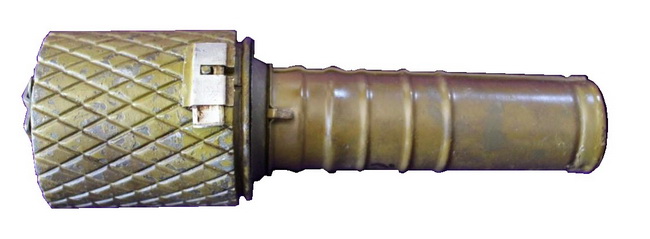
The RGD 33, the
Russian equivalent to the Stielhandgranate 24.
It had a detachable
fragmentation sleeve that could be used when the thrower had good
cover, for example when under attack in trenches. The information about
this grenade with the detachable fragmentation sleeve was reported from
the front directly back to the
Reichsführer SS Heinrich Himmler, who had his own informants in the
Waffen SS units fighting on the southern part of the Eastern front. And
that was the start of the strange story about the fragmentation sleeve
for the Stielhandgranate 24. The SS-Waffenamt, responsible for the
weapons and equipment used by the Waffen SS, with its leader
SS-Oberführer Gärtner was against the idea from the start. A direct
order from the Reichsführer SS (RfSS) to develop a copy of the Russian
construction was issued on 16. June 1942. In a memorandum dated 11.
July the same year the SS-Waffenamt informs the SS-Führungsamt that a
fragmentation sleeve has allready been developed, but only for use with
a mechanism used to launch handgrenades from permanent fortified
positions. A fragmentation sleeve for the Stielhandgranate 24 had not
been developed due to several reasons. The device would be lethal for
all personell within a radius of 100 meters, not
only
killing the thrower but all his fellow soldiers. This would make it
unsuitable for anything but trench warfare. Further on it would
increase the weight of the grenade, de-creasing the throwing distance
possible, and it would mean a higher consumption of steel by the
industry. According to the document, the RfSS had been informed and
accepted the negative information, but had still ordered development
and testing of a prototype. The Heeres Waffen-amt was informed about
the project on 13. July 1942 and invited to participate, but the Chief
of Staff of the Heeres Waffen-amt, Oberst Löhr, was also against the
idea, using the same arguments. But on 7. January 1943 a new letter
from Oberst Löhr to SS-Oberführer
Gärtner informed him that the Heeres Waffen-amt had completely changed
their mind; the danger to the thrower was by then viewed as acceptable
if he took cover. Due to this, the Heeres Waffen-amt
had
started developing a model based on the RGD 33 fragmentation sleeve
with pre-cut squares. But in the mean time Generalmajor Gerloff of the
Technischen SS- und Polizei Akademie had developed a new version that
was supposed to be less lethal for the thrower. It consisted of a
smooth circular spring with the thickness of 1,5 mm that would be
attached to the head simply by the built in tension of the steel. This
model had allready been shared with the Heeres Waffenamt, but they had
obviously decided to develop their own model. Despite this the
SS-Waffenamt sent the Heeres Waffenamt 100 examples of their smooth
sleeve for trials in January 1943. A head from the Stielhandgranate 24
was set off with a electric detonator, and plywood boards of 20 mm and
40 mm thickness were set up at different distances, used to count the
number of hits and penetration ability of the fragments.
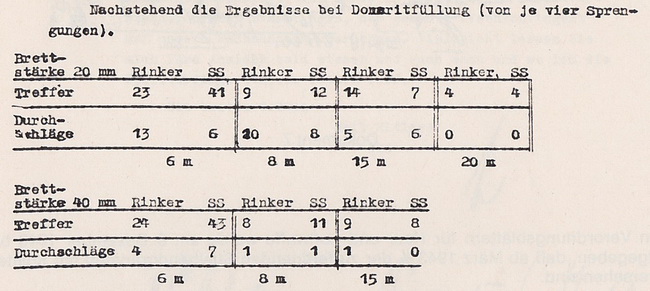
The
SS model resulted in more, but lighter fragments, loosing it's effect
beyond 10 meters. The Heeres Waffenamt concluded that the best
fragmentation sleeve would be the one developed by Richard Rinker (the
Heeres model), as it was decided that the thrower would be using the
grenade from cover. The SS model was described as
"considerably
easier and quicker to manufacture in large numbers", but not likely to
wound the enemy standing more than 15 meters away from the blast.
The
SS Waffenamt and the Heeres Waffenamt ended up with different
conclusions, as their criteria were different from the start. The Heer
wanted a fragmentation sleeve that would have the maximum of effect,
since they would only be thrown by personel that had sufficient cover
in the defensive rolle. The SS wanted a fragmentation sleeve
that
would be effective during assault without danger to the thrower.
 In
a letter dated 18 February 1943 the approbation of the Heeres model was
announced by the Heeres Waffenamt "without further trials by the
troops". But since the tooling and machinery for the Heeres model would
take some time to organize, it was suggested in the same document that
production of the SS model should start as soon as possible as a
"stop-gap" measure. This lead to the peculiar situation that the
procurement office of the Heer actually ordered both models made.
In
a letter dated 18 February 1943 the approbation of the Heeres model was
announced by the Heeres Waffenamt "without further trials by the
troops". But since the tooling and machinery for the Heeres model would
take some time to organize, it was suggested in the same document that
production of the SS model should start as soon as possible as a
"stop-gap" measure. This lead to the peculiar situation that the
procurement office of the Heer actually ordered both models made.
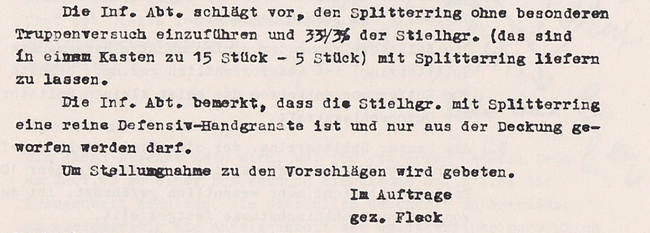
The
distribution method and number of fragmentation sleeves had allready
been suggest in a letter dated 3. February 1943 (above) from the Chef
des Heeresrüstung to the Chef des Infanterie. 5 out of the 15
Stielhandgranate 24 in a standard transport box would be pre-fitted
with the fragmentation sleeve at the factory. With a monthly production
output of up to 1 million Stielhandgranaten 24 this meant a
corresponding monthly production of 330.000 fragmentation sleeves.
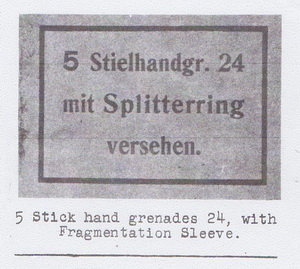 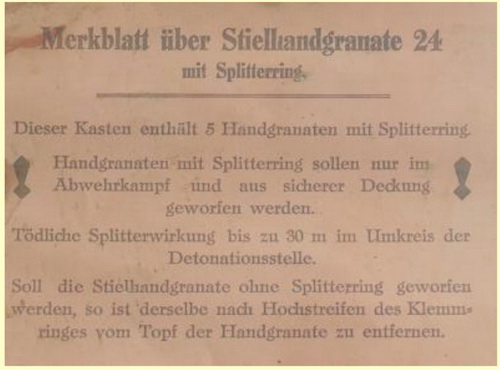
The
transportation boxes were marked with the new contents as shown above
to the left (this picture was printed in the Recognition handbook for
German ammunition, April 1945, published by SHAEF). There was also a
loose leaf (Merkblatt) in the box with the appropriate warnings, and
instructions for removal of the sleeve if the handgrenades would be
used without the fragmentation sleeve. Of interest is the much lower
"danger zone". When the SS-Waffenamt was against the initial idea they
claimed the radius to be 100 meter, but this warning label claims 30
meter.
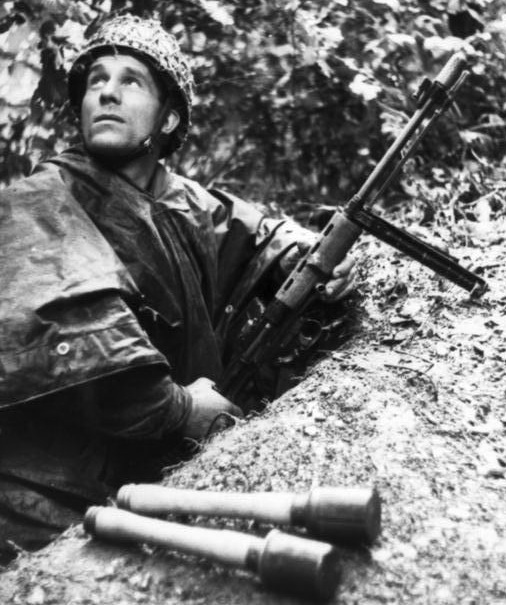
A
Fallschirmjäger armed with a FG42 and two Stielhandgranate 24, pictured
by Kriegsberichter Arthur Grimm somewhere in France during the summer
of 1944. Note that one out of the two handgrenades has been fitted with
the SS-model of the fragmentation ring.
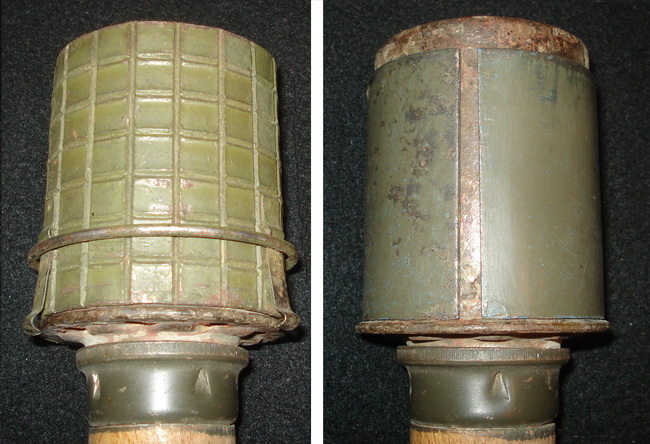
Both
models shown above. The Heeres model was manufactured by Richard Rinker
in 1943, marked "brb 43", it is shown with the attaching ring open. The
SS-model is slightly shorter than the head and held only by the
friction created by the spring tension. The sleeve could be pushed all
the way down or attached at the end, like the picture of the
Fallschirmjäger above shows. Both models are painted ordnance
green on both the inside and outside. The SS model carries no marking.
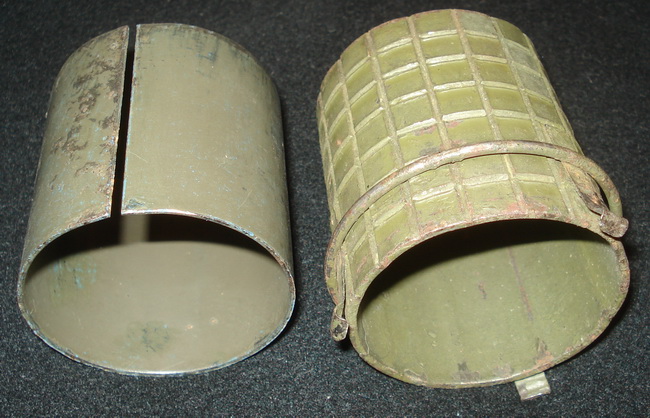
The
Heeres model was made from rolled sheet metal of "Thomas-qualität" that
was welded to a tubular shape, with the welding seam visible on the
inside. It would then be heated and the pattern was rolled into it,
creating slightly irregular squares. Then the ring was fitted, with the
three springs in turn spot-welded in position, and finally the whole
assembly painted.
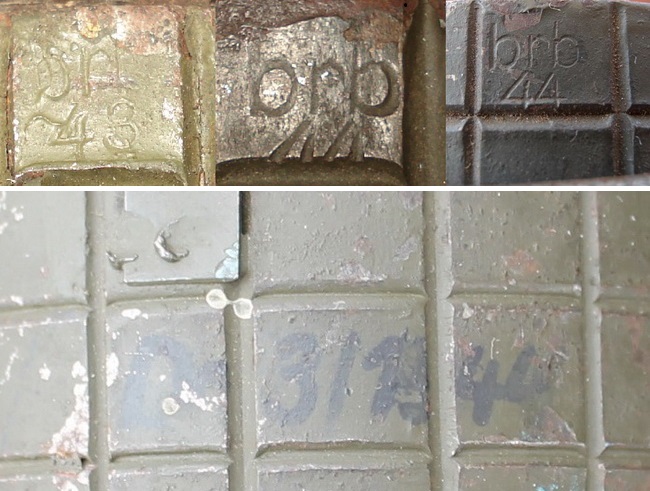
The makers code on the fragmentation sleeve was pressed into one of the
squares closest to the bottom edge (with the attaching springs).
The lower picture above shows the text "Do 3/1944" inked on the body of
a brb44 fragmentation sleeve.

The fragmentation sleeve is mounted on a matching 1944 brb. It is very
likely that Richard Rinker stamped the explosive contents filling to
the fragmentation sleeve after the sleeve was factory mounted to the
grenade head.
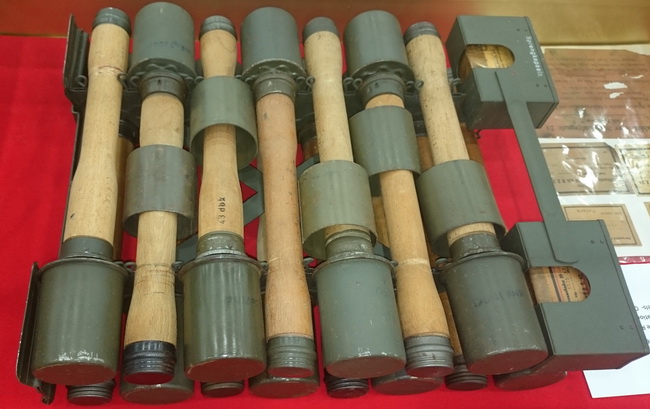
The picture above shows a complete transport frame offered for sale at
the SOS 2015. Note how the fragmentation rings of the SS-model have
just been put on the handle, most probably by the seller to better
display his merchandise.
Packing
material
& transport

A
german POW at work sorting and defusing grenades. Both models of the
transport box are visible.
The
Stielhandgranate 24 was shipped, handled and stored in two different
transport boxes; one wooden and one made from steel. Both boxes
contained 15 Stielhandgranaten 24, one box of 15 Brennzünder 24 and one
box of 15 Sprengkapseln Nr. 8. Both due to stability and safety the
handgrenades were not assembled until they had reached the units and
were needed.

The
first model of the transport box was made like a suitcase. It contained
a separate rack that held the grenades in spring clips and had separate
pockets for the detonators and fuses. If needed, the grenades could be
carried in the rack alone.
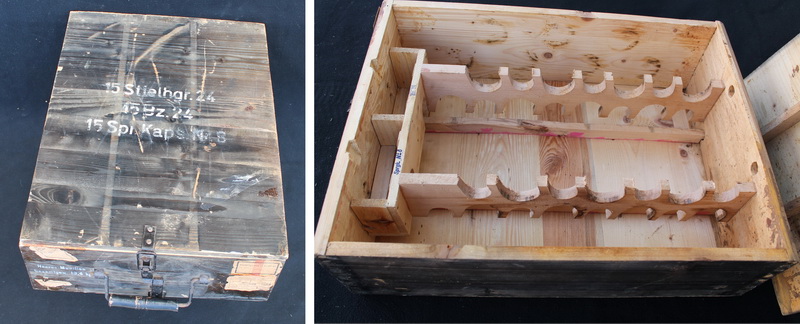
The
second model was made of wood. It had a detachable lid on both sides
and an internal rack that held the grenades. There were also two
separate compartments for the boxes containing the fuses and detonators.
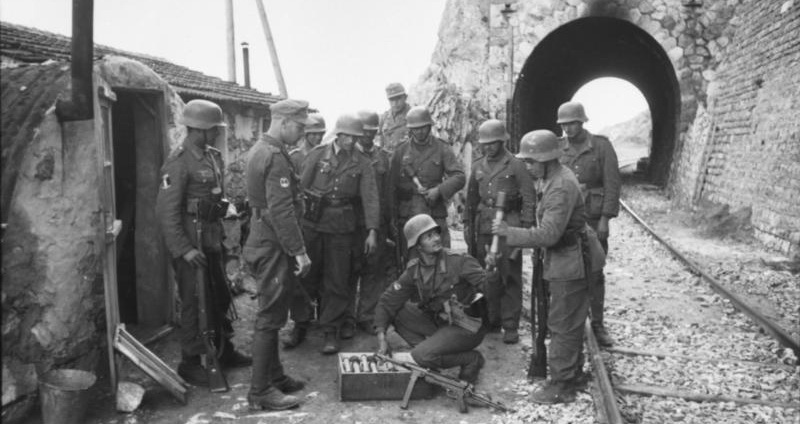
Autumn
1943. Stielhandgranaten 24 is distributed among soldiers of the Legion
Freies Arabien in Greece. Note the wooden transport box.
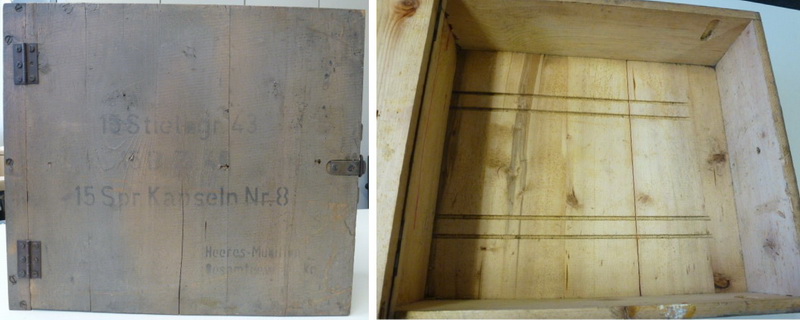
A
1945-dated, simplified transport box for 15 Stielhandgranaten 43. This
box was constructed with only one lid and is missing the interior,
which must have been
detachable.
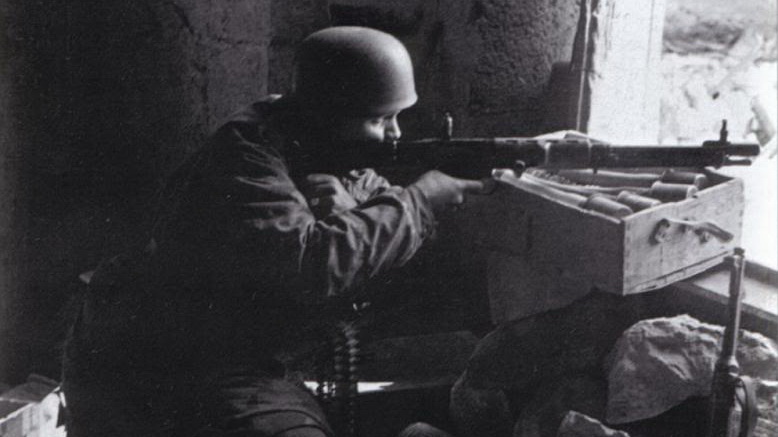
Any
box would do of course. The grenades in this picture from Monte
Cassino, early 1944, has been placed in a standard "Patronenkasten 88"
box. The picture was taken by Kriegsberichter Wahner, which undoubtebly
"arranged" the picture. The grenades actually belong in a standard
wooden box that is situated behind the gunner, and would not do well in
the "line of fire".
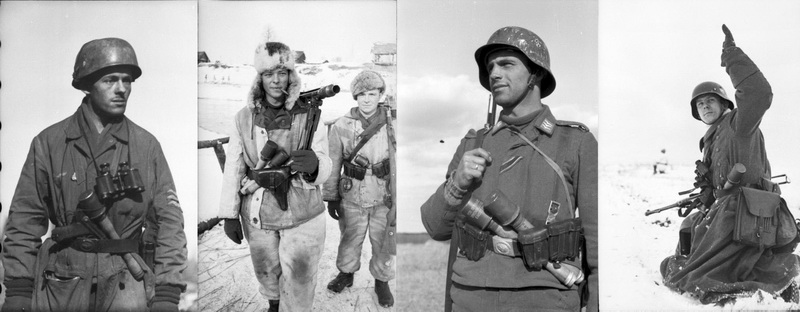
The normal way to transport the Stielhandgranat 24 was to tuck it
inside the belt.

Other
alternative carrying methods. The bicycle rider has tied a string to
each handle and slung them around his neck. The Unterfeldwebel in the
centre picture has, very unusually, placed a grenade upside-down behind
his belt. The Luftwaffe guard has tucked 4 grenades behind his Y-straps.
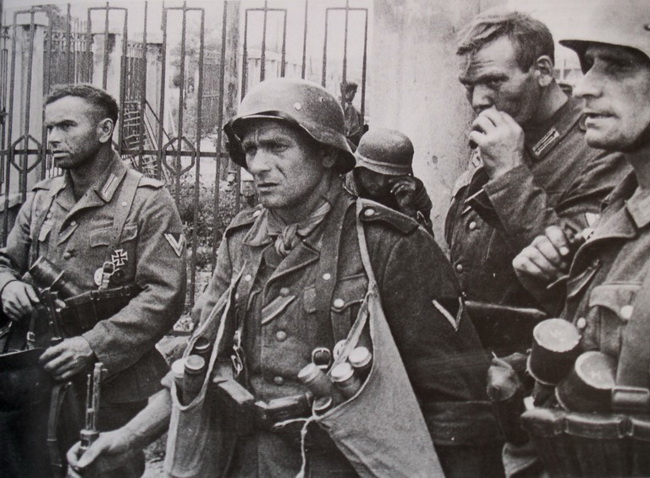
A set of specially constructed bags xxxxxxxxxxx
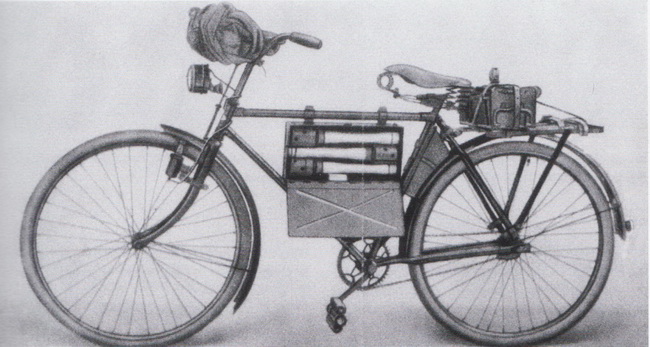
The
German infantry bicycle had a box mounted within the frame that would
take a box of 250 rounds of MG ammunition, or three Stielhandgranaten
24. In this picture from a temporary manual it is shown with the
Übungsstielhandgranate 24.
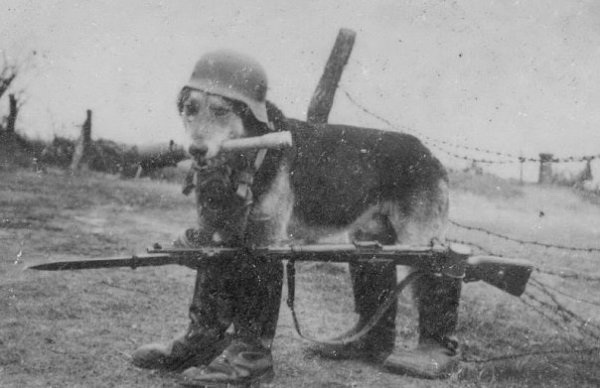
As
long as the classical "Knobelbecher" marching boots were distributed
and used, the Stielhandgranaten could be worn inside the boot.
|


 Stielhandgranate
24
Stielhandgranate
24 